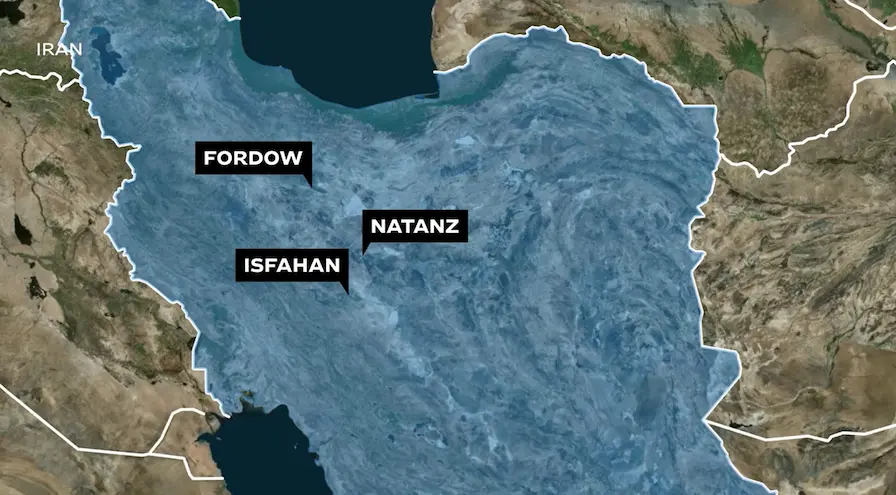
Iran vows immediate retaliation after U.S. B-2 bombers strike key nuclear facilities.
US Airstrikes Ignite a Firestorm
US Bombs 3 Nuclear Sites – In a dramatic escalation of the Iran-Israel conflict, the United States launched precision airstrikes on three Iranian nuclear facilities using B-2 stealth bombers on June 22, 2025. The Pentagon has yet to release full details, but sources confirm the strikes targeted underground enrichment sites believed to be central to Iran’s nuclear ambitions.
The move, reportedly coordinated with Israeli intelligence, marks a significant shift in U.S. policy from deterrence to direct intervention. President Donald Trump defended the action as a “necessary step to prevent a nuclear-armed Iran,” while critics warn it could trigger a full-scale regional war.
Iranian state media confirmed the attacks but claimed minimal damage, asserting that key personnel and assets had been relocated in anticipation. However, the symbolic weight of the strikes has galvanized Iran’s leadership and public, setting the stage for a dangerous retaliation.
The U.S. airstrikes on Iran targeted three major nuclear facilities: Fordow, Natanz and Isfahan.
- Fordow Enrichment Facility: Located about 100 km southwest of Tehran, this site is deeply buried under a mountain and heavily fortified. It was reportedly the primary target, with a full payload of bombs dropped by B-2 bombers.
- Natanz Enrichment Facility: Situated roughly 220 km southeast of Tehran, Natanz is Iran’s main uranium enrichment site. It houses multiple cascades of centrifuges and has been a focal point of Iran’s nuclear program.
- Isfahan Nuclear Complex: This facility includes uranium conversion and fuel fabrication plants. It plays a key role in Iran’s nuclear fuel cycle and is home to thousands of nuclear scientists.
Tehran’s Fury: “Our Turn to Act Without Delay”
Hours after the strikes, Hossein Shariatmadari, a close aide to Supreme Leader Ayatollah Ali Khamenei, issued a fiery statement: “It is now our turn to act without delay.” He called for immediate missile strikes on the U.S. naval fleet stationed in Bahrain and the closure of the Strait of Hormuz to Western vessels.
The Strait of Hormuz, a narrow waterway between Iran and Oman, is one of the world’s most critical oil chokepoints, facilitating nearly 20% of global oil trade. Any disruption could send energy prices soaring and destabilize global markets.
Iran’s Foreign Ministry also condemned the U.S. action as a “grave violation of international law,” accusing Washington of attacking peaceful nuclear infrastructure. “This is not just an act of war, it is a declaration of hostility against the Iranian people,” said Foreign Minister Seyed Abbas Araghchi.
Meanwhile, Supreme Leader Khamenei warned that the U.S. should expect “greater damage than ever before,” signaling that Iran’s response may not be limited to rhetoric.
Global Fallout: Oil Shock and Diplomatic Paralysis
The geopolitical shockwaves were immediate. Oil prices surged by over 5% within hours of the announcement, with Brent crude nearing $100 per barrel. Energy-dependent nations like India and China expressed concern over supply disruptions, while European leaders called for urgent de-escalation.
The United Nations Secretary-General António Guterres issued a grave warning, stating that “there is no military solution to this crisis” and urging all parties to return to diplomacy. However, with both Washington and Tehran digging in, the path to dialogue appears increasingly narrow.
The U.S. Navy has reportedly raised its alert level in the Persian Gulf, while Israel has placed its air defense systems on high readiness. Russia and China, long-time critics of U.S. interventionism, condemned the strikes and called for an emergency UN Security Council session.
Back in Iran, nationalist fervor is surging. Crowds gathered in Tehran chanting anti-American slogans, while lawmakers demanded immediate military retaliation. The Iranian Revolutionary Guard Corps (IRGC) has reportedly mobilized missile units and naval forces in the Gulf.
Conclusion: US Bombs 3 Nuclear Sites
The U.S. bombing of Iranian nuclear sites has shattered the fragile status quo in the Middle East. With Iran threatening to strike U.S. assets and choke off global oil supplies, the world stands on the brink of a conflict that could reshape the geopolitical landscape.
Whether this moment becomes a turning point for diplomacy or a descent into chaos depends on what happens next, and how quickly cooler heads can prevail.
Stay updated with the latest news on Rapido Updates. Keep yourself updated with The World, India News, Entertainment, Market, Gadgets, Sports, and many more
1 thought on “US Bombs 3 Nuclear Sites- Red Line Crossed: Iran Threatens Missile Strikes”